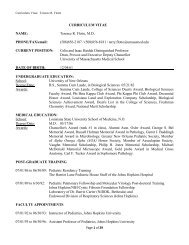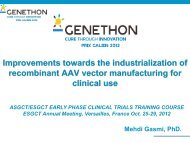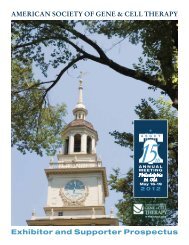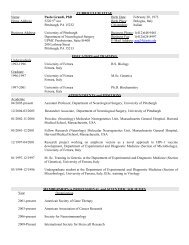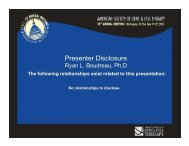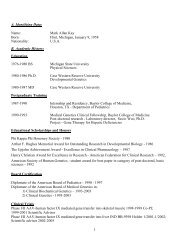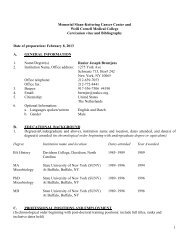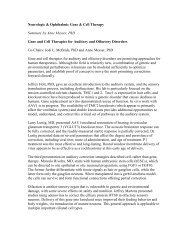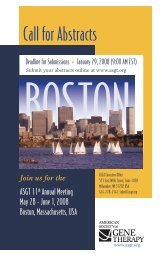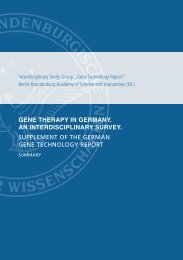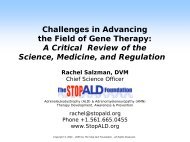13 th AnnUAL MEETing | Washington, DC USA May 19-22, 2010 69Program ScheduleYiping Yang, MD, PhDInnate Immunity in AAV-mediated <strong>Gene</strong> <strong>Therapy</strong>Recombinant adeno-associated viruses (AAVs) have been used widely for in vivo gene therapy. However, adaptive immune responses to AAV have posed a significanthurdle in clinical application <strong>of</strong> AAV vectors. Recent advances have suggested a crucial role for innate immunity in shaping adaptive immune responses. Here I will discusshow AAV activates the innate immune system and the potential implications for improving the outcome <strong>of</strong> AAV-mediated gene therapy.David B. Weiner, PhDHigh Immune Potency <strong>of</strong> Highly Optimized EP DNA Vaccines in Animal Models and HumansDNA vaccines are an important emerging vaccine technology, however the immune responses induced by past generations <strong>of</strong> DNA vaccines were poor in larger animalsincluding nonhuman primates and importantly humans. We have recently utilized a combination <strong>of</strong> technologies for plasmid optimization, combined with enhanced EPdelivery to dramatically improve the immune potency <strong>of</strong> this platform. These new EP systems also <strong>of</strong>fer improved tolerability and effectiveness. We will present data inanimal models and humans illustrating immune aspects <strong>of</strong> the technology for application to human infectious diseases.Michael T. Lotze, MDMicroRNAs in Immune Regulation-Opportunities for Cancer <strong>Gene</strong> <strong>Therapy</strong>Initially considered as means to regulate tissue differentiation and disordered in cancer, miRNAs [miR] have now been identified that are induced in response to hypoxia,oncogenic signaling, pathogens and tissue damage or injury. Each miR can regulate the translation <strong>of</strong> up to 100 separate mRNAs. Means to either express or knockdownmiRNA expression [so-called antagomiRs] have been operationalized in murine models and represent exciting novel targets for modifying immunity.Scientific Symposium 4048:30 am - 10:30 amRoom: Wilson ABCMicroRNA and siRNA Roles in Disease Progression and Development <strong>of</strong> Novel Therapeutic TargetsChairMaria G. Castro, PhDSpeakersAnna M. Krichevsky, PhDMicroRNAs as Targets for Glioma <strong>Therapy</strong>MicroRNA (miRNA) is a class <strong>of</strong> small RNA molecules involved in the regulation <strong>of</strong> expression <strong>of</strong> at least 30% <strong>of</strong> human genes and, therefore, it controls all principalcellular processes, including cell division and cell death. In my talk, I will describe our approach to reveal key miRNA regulators in human diseases and focus on miRNAfunctions in the development <strong>of</strong> human brain tumors. Our recent work presents pro<strong>of</strong>-<strong>of</strong>-principles that specific inhibition <strong>of</strong> a single oncogenic miRNA could provide a noveltherapeutic approach for physiological modulation <strong>of</strong> multiple proteins whose expression and activity is de-regulated in cancer. It also suggests a diagnostic potential forthis novel class <strong>of</strong> molecules.M. Maral Mouradian, MDMicroRNAs in Parkinson’s Disease and Other Neurodegenerative Disordersalpha-Synuclein is a key protein that accumulates in the brains <strong>of</strong> patients with Parkinson’s disease and related neurodegenerative disorders. Evidence from clinical geneticstudies, animal models and cell biologic experiments indicate that elevated levels <strong>of</strong> this protein are toxic. This presentation will discuss down-regulation <strong>of</strong> alpha-synucleinexpression by microRNA leading to neuroprotection.Sean E. Lawler, PhDMicroRNA Alterations and Functions in GlioblastomaMicroRNAs have recently emerged as important regulators <strong>of</strong> gene expression with potential therapeutic applications in many human diseases. We have identified extensivealterations in microRNA expression in the malignant brain tumor glioblastoma multiforme. We have shown that altered microRNAs play roles in proliferation, stemcell-like behavior, and glioma cell migration. This talk will focus on the underlying mechanisms <strong>of</strong> microRNA action in glioblastoma, and their therapeutic potential.Saturday, May 22 nd
70<strong>American</strong> <strong>Society</strong> <strong>of</strong> <strong>Gene</strong> & <strong>Cell</strong> <strong>Therapy</strong>Program ScheduleAl Charest, PhDNanoparticle-Mediated Delivery <strong>of</strong> siRNA in a Pre-Clinical Mouse Model <strong>of</strong> Glioblastoma MultiformeSmall interfering RNAs mediate cleavage <strong>of</strong> specific, complementary mRNA sequences and thus regulate gene expression. Not surprisingly, their use for treatment <strong>of</strong>diseases that are rooted in aberrant gene expression, such as cancer, has become a paradigm that has gained wide interest. We utilized dendrimer-conjugated magnet<strong>of</strong>luorescentnanoparticles to deliver anti-EGFR siRNA in vivo in an EGFR-driven transgenic model <strong>of</strong> glioblastoma. These nanoparticles were well tolerated in the CNS anddemonstrated specific and significant suppression <strong>of</strong> EGFR expression by convection-enhanced delivery to the mouse brain. Our data demonstrate the feasibility <strong>of</strong> siRNAdelivery in animals using a nanoplatform to efficiently knockdown target proteins.Scientific Symposium 4058:30 am - 10:30 amRoom: Marriott Ballroom Salons 2 & 3Special Considerations with Using Viral Vectors for <strong>Gene</strong> Modification <strong>of</strong> Stem <strong>Cell</strong>sChairPhilip D. Gregory, PhDSpeakersMatthew Hirsch, PhDThe AAV Induced DNA Damage Response in Human Pluripotent <strong>Cell</strong>sThe ability to genetically engineer stem cells ex vivo, then re-introduce them into a host for therapeutic purposes is an attractive approach for a variety <strong>of</strong> human geneticdiseases. Critical in this process is the ability to efficiently deliver transgenic DNA into the nucleus <strong>of</strong> stem cells in a manner that is well tolerated by the cell and withoutextensive host chromosome integration. A concern at the cellular level is the characterization <strong>of</strong> the cell type modified, and in particular, understanding the relationshipbetween “stemness” and oncogenesis. For example, the DNA damage response <strong>of</strong> pluripotent human embryonic stem cells (hESCs), in general, differs from that <strong>of</strong>differentiated cells in that checkpoint functions are impaired and that these cells appear primed for rapid apoptosis. In this work, incidentally, we demonstrate that theadeno-associated virus (AAV) origin <strong>of</strong> replication, found ubiquitous in nature and currently used in human clinical trials for DNA delivery, induces a rapid, specific, andcomplete apoptotic response following transduction <strong>of</strong> non-differentiated hESCs. <strong>Cell</strong> cycle analysis by flow cytometry suggested that AAV-infected hESCs fail to induce aG1 checkpoint response and display an accumulation <strong>of</strong> cells in early S phase followed by apoptosis, suggesting that the AAV ITRs mimic stalled replication forks and/orperhaps uncapped telomeres. In contrast to reports <strong>of</strong> AAV-induced apoptosis in p53-deficient cancers, hESCs depleted <strong>of</strong> p53 survived significantly longer following AAVinfection than the parental control. Collectively, these data demonstrate that the AAV origin <strong>of</strong> replication (present on all AAV vectors) induces a lethal signaling cascadeduring S-phase in hESCs and a subsequent p53-dependent apoptotic response. This unexpected phenomenon is the first report <strong>of</strong> AAV vector toxicity in a wild type humancell and is reminiscent <strong>of</strong> previous reports <strong>of</strong> toxicity in p53-deficient cancers cells following AAV transduction. Understanding such unique DNA damage responses in stemcells and cancers following DNA delivery is necessary for optimization <strong>of</strong> conditions for efficient genetic engineering and safety in cell replacement therapies.Saturday, May 22 ndPhilip D. Gregory, hDStem <strong>Cell</strong> Modification with Zinc Finger NucleasesFrederic Paques, PhDMeganucleases and Viral Vectors: Alternative or Complementary ApproachesTargeted approaches have emerged today as an alternative to current random insertion strategies for gene therapy. Meganucleases, the most specific natural endonucleasesrepresent ideal tools for targeted genome editing, or “genome surgery”. Natural as well as engineered can be used to induce up to 20% <strong>of</strong> gene insertion into chosenhuman genes. The introduction <strong>of</strong> meganucleases into different cell types can be achieved by various means, including viral and non viral vectorization.Andrew M. Scharenberg, MD<strong>Gene</strong> Editing Using Lentiviral Expression <strong>of</strong> Homing Endonucleases<strong>Gene</strong> editing and targeted integration approaches to gene therapy <strong>of</strong>fer the potential to avoid idiosyncratic side effects associated with the random integration <strong>of</strong>promoter/gene cassettes in traditional gene therapy. The Northwest Genome Engineering Consortium is exploring the development <strong>of</strong> lentiviral vector-mediated expression<strong>of</strong> homing endonucleases for gene editing and targeted integration in hematopoietic cells. Preliminary data on the efficacy <strong>of</strong> this approach in cultured and primaryhematopoietic cell models will be presented, and challenges and future directions in the field will be discussed.Break10:30 am – 11:00 amEXHIBITOR PROSPECTUSfinal program
- Page 1 and 2:
FINAL PROGRAMAmerican Society of Ge
- Page 4:
13 th AnnUAL MEETing | Washington,
- Page 7 and 8:
6American Society of Gene & Cell Th
- Page 12 and 13:
13 th AnnUAL MEETing | Washington,
- Page 20 and 21: 13 th AnnUAL MEETing | Washington,
- Page 22 and 23: 13 th AnnUAL MEETing | Washington,
- Page 24 and 25: 13 th AnnUAL MEETing | Washington,
- Page 26 and 27: 13 th AnnUAL MEETing | Washington,
- Page 28 and 29: 13 th AnnUAL MEETing | Washington,
- Page 30 and 31: 13 th AnnUAL MEETing | Washington,
- Page 32 and 33: 13 th AnnUAL MEETing | Washington,
- Page 34 and 35: 13 th AnnUAL MEETing | Washington,
- Page 36 and 37: 13 th AnnUAL MEETing | Washington,
- Page 38 and 39: 13 th AnnUAL MEETing | Washington,
- Page 40 and 41: 13 th AnnUAL MEETing | Washington,
- Page 42 and 43: 13 th AnnUAL MEETing | Washington,
- Page 44 and 45: 13 th AnnUAL MEETing | Washington,
- Page 46 and 47: 13 th AnnUAL MEETing | Washington,
- Page 48 and 49: 13 th AnnUAL MEETing | Washington,
- Page 50 and 51: 13 th AnnUAL MEETing | Washington,
- Page 52 and 53: 13 th AnnUAL MEETing | Washington,
- Page 54 and 55: 13 th AnnUAL MEETing | Washington,
- Page 56 and 57: 13 th AnnUAL MEETing | Washington,
- Page 58 and 59: 13 th AnnUAL MEETing | Washington,
- Page 60 and 61: 13 th AnnUAL MEETing | Washington,
- Page 62 and 63: 13 th AnnUAL MEETing | Washington,
- Page 64 and 65: 13 th AnnUAL MEETing | Washington,
- Page 66 and 67: 13 th AnnUAL MEETing | Washington,
- Page 68 and 69: 13 th AnnUAL MEETing | Washington,
- Page 72 and 73: 13 th AnnUAL MEETing | Washington,
- Page 74 and 75: 13 th AnnUAL MEETing | Washington,
- Page 76 and 77: 13 th AnnUAL MEETing | Washington,
- Page 78 and 79: 13 th AnnUAL MEETing | Washington,
- Page 80 and 81: 13 th AnnUAL MEETing | Washington,
- Page 82 and 83: 13 th AnnUAL MEETing | Washington,
- Page 84 and 85: 13 th AnnUAL MEETing | Washington,
- Page 86 and 87: 13 th AnnUAL MEETing | Washington,
- Page 88 and 89: 13 th AnnUAL MEETing | Washington,
- Page 90 and 91: 13 th AnnUAL MEETing | Washington,
- Page 92 and 93: 13 th AnnUAL MEETing | Washington,
- Page 94 and 95: 13 th AnnUAL MEETing | Washington,
- Page 96 and 97: 13 th AnnUAL MEETing | Washington,
- Page 98 and 99: 13 th AnnUAL MEETing | Washington,
- Page 100 and 101: 13 th AnnUAL MEETing | Washington,
- Page 102 and 103: 13 th AnnUAL MEETing | Washington,
- Page 104 and 105: 13 th AnnUAL MEETing | Washington,
- Page 106 and 107: 13 th AnnUAL MEETing | Washington,
- Page 108 and 109: 13 th AnnUAL MEETing | Washington,
- Page 110 and 111: 13 th AnnUAL MEETing | Washington,
- Page 112 and 113: 13 th AnnUAL MEETing | Washington,
- Page 114 and 115: 13 th AnnUAL MEETing | Washington,
- Page 116 and 117: 13 th AnnUAL MEETing | Washington,
- Page 118 and 119: 13 th AnnUAL MEETing | Washington,
- Page 120 and 121:
13 th AnnUAL MEETing | Washington,
- Page 122 and 123:
13 th AnnUAL MEETing | Washington,
- Page 124 and 125:
13 th AnnUAL MEETing | Washington,
- Page 127 and 128:
126American Society of Gene & Cell
- Page 129 and 130:
128American Society of Gene & Cell
- Page 131 and 132:
130American Society of Gene & Cell
- Page 133 and 134:
132American Society of Gene & Cell
- Page 135 and 136:
134American Society of Gene & Cell
- Page 137 and 138:
136American Society of Gene & Cell
- Page 139 and 140:
138American Society of Gene & Cell
- Page 141 and 142:
140American Society of Gene & Cell
- Page 143 and 144:
142American Society of Gene & Cell
- Page 145 and 146:
144American Society of Gene & Cell
- Page 147 and 148:
146American Society of Gene & Cell
- Page 149 and 150:
148American Society of Gene & Cell
- Page 151 and 152:
150American Society of Gene & Cell
- Page 153 and 154:
152American Society of Gene & Cell
- Page 155 and 156:
154American Society of Gene & Cell
- Page 157 and 158:
156American Society of Gene & Cell
- Page 159 and 160:
158American Society of Gene & Cell
- Page 161 and 162:
160American Society of Gene & Cell
- Page 163 and 164:
162American Society of Gene & Cell
- Page 165 and 166:
164American Society of Gene & Cell
- Page 167 and 168:
166American Society of Gene & Cell
- Page 169 and 170:
168American Society of Gene & Cell
- Page 171 and 172:
170American Society of Gene & Cell
- Page 173 and 174:
172American Society of Gene & Cell
- Page 175 and 176:
174American Society of Gene & Cell
- Page 177 and 178:
176American Society of Gene & Cell
- Page 179 and 180:
178American Society of Gene & Cell
- Page 181 and 182:
180American Society of Gene & Cell
- Page 183 and 184:
182American Society of Gene & Cell
- Page 185 and 186:
184American Society of Gene & Cell
- Page 187 and 188:
186American Society of Gene & Cell



